The brown recluse spider has been dubbed one of the most dangerous spiders in the US. Although this is somewhat true, these venomous spiders are often misidentified and misunderstood, which is why people are getting more afraid of them. But to protect yourself, get rid of them as early as possible.
How to get rid of brown recluse spiders? Vinegar and some essential oil solutions repel brown recluse spiders. Remove their sources of food and their possible hideouts. If your last option is to kill them, use a vacuum cleaner, bottle traps, or sticky traps. Diatomaceous Earth (DE) is also an effective way to get rid of them.
Brown recluse spiders feed on small insects, including mosquitoes, crickets, and roaches. But despite being beneficial arachnids, they can also be dangerous, especially in the fall season when they are most active. Just like most spider species, these insect predators use venom to subdue their prey. Continue reading to learn more about them.
How to Tell if a Spider Is a Brown Recluse?
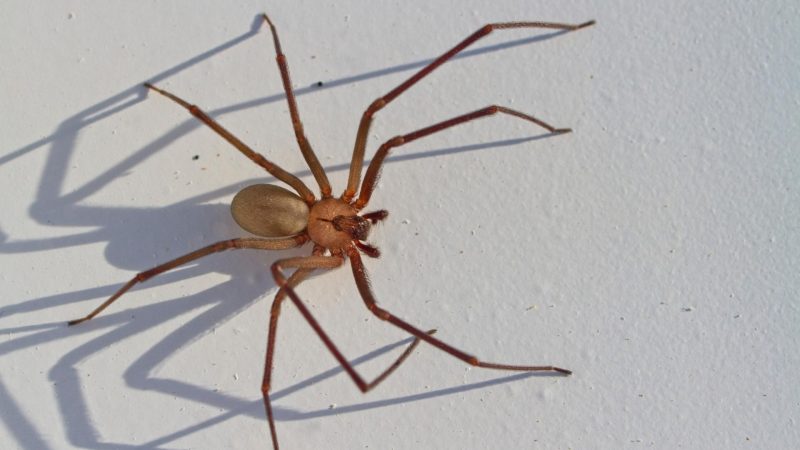
Scientifically known as Loxosceles recluse, brown recluse spiders are usually mistaken for other spider species. This is because most of their notable physical characteristics are also seen in other non-hazardous spiders. Therefore, not knowing how to identify them clearly can confuse you and will add worries.
First of all, most brown recluse spiders have a dark violin-shaped mark on their cephalothorax (head and thorax). This is why they are sometimes referred to as violin spiders or fiddle back spiders. However, not all of them have this marking. So, don’t use it solely to identify them. This is the most unreliable mark.
Aside from that, brown recluse spiders only have six eyes while most of the other spider species have eight. But some species of cellar spiders and spitting spiders also have 6 eyes. However, the arrangement of the eyes of brown recluse spiders is very different. One pair of their eyes is in front, and a pair is on each side.
As their name implies, brown recluse spiders are uniformly dark cream or dark brown. Their abdomen may also have the same single-color pigmentation, but it can be light or dark, depending on what they last ate. If their abdomen has more than one color, they are not recluses. Instead, they could be huntsman spiders.
Male and female brown recluse spiders have the same appearance. Some people claim that there are also violin marks on the top and bottom of their abdomen. However, they are only dark lines that can be mistaken for violins. These lines are very small, and you need a magnifying glass to see them.
What Is the Size of a Brown Recluse Spider?
Brown recluse spiders are relatively small and are only as big as the diameter of a quarter, with their legs extended. On average, they are 3/8 inch (9.5 mm.) long, and their maximum length is only ½ inch (12.7 mm.) If you see a brown spider that is longer than ½ inch, it is not a brown recluse spider.
How Many Legs Does a Brown Recluse Spider Have?
Brown recluse spiders have eight legs, just like other spider species. Note that spiders are not insects but arachnids. But to differentiate them from the rest, they have elongated, slanted legs that have a uniform color and fine hairs. Brown recluse spiders also lack conspicuous spines, and they hold their legs at rest.
How Dangerous Is Brown Recluse?
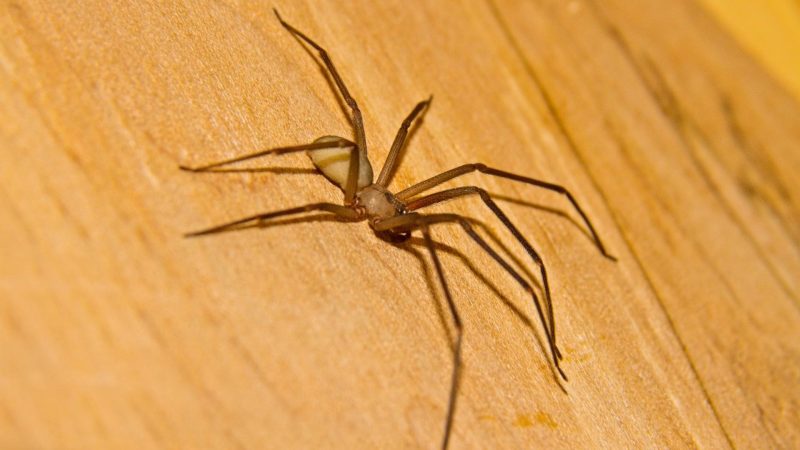
Brown recluse spiders are potentially dangerous, but only because their bites are painful, and victims should be treated immediately. They possess venom called cytotoxin, which can potentially inflict injury to humans, especially to the elderly and small children. However, they rarely bite people unless provoked or threatened.
Spiders are not known for carrying germs and transmitting diseases. They also avoid humans, which is why you seldom see them unless during spider season. But even so, spiders don’t bite people unless they are rolled over, slowly being crushed between skin and objects, or other similar instances that can harm them.
Are Brown Recluse Spiders Poisonous?
Brown recluse spiders are not poisonous but venomous. Unfortunately, these two terms are usually used interchangeably, but they have different meanings. Technically speaking, poison is something that enters a body when inhaled, swallowed, or absorbed through the skin while venom is injected into the skin.
What Happens if a Brown Recluse Bites You?
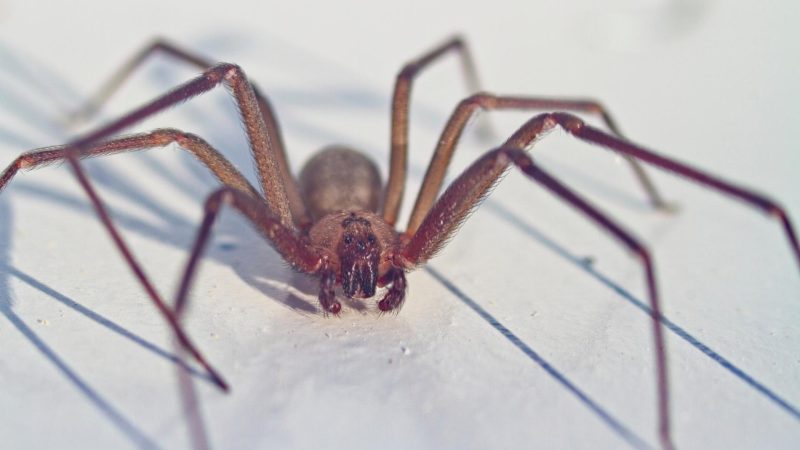
Once a brown recluse spider bites you, you may not feel the pain immediately. You will be unaware that you have been bitten unless you saw the spider biting you. But after about two hours, you will start to feel the stinging sensation and other symptoms. In most cases, you will no longer need special medical treatments.
What Are the Symptoms of a Brown Recluse Spider Bite?
As mentioned earlier, brown recluse spider bites are usually not initially felt. Sad to say, many people have been diagnosed as having brown recluse spider bites. But the problem is due to other medical issues and not a spider bite. Nevertheless, here are some symptoms that a brown recluse spider bites you:
- Your skin is getting itchy, red, and painful. The pain will increase as hours go by.
- The bite wound is pale at the center that will later turn dark blue or purple.
- A red ring will surround the wound, which will look like a bull’s eye target.
- In some cases, there will be some dead tissues on the inflamed skin.
- Within 12-36 hours, the dead tissues may extend to 10 inches (25 cm) long.
- Fever, dizziness, body ache, and vomiting.
Note: The severity of the spider bite depends on the amount of venom injected into your skin, as well as your health condition.
How to Treat a Brown Recluse Spider Bite?
So far, no scientific studies are proving any medicine that can counteract the venom spiders, not even antibiotics. To treat spider bites, use the RICE therapy – Rest, Ice, Compression, and Elevation. This technique is also used as first aid against knee or ankle sprain and injuries on joints, bones, and muscles.
- Rest – Stopping your activity that can add to the pain
- Ice – Apply ice to the wound for about 15 minutes, at least three times a day.
- Compression – Wrapping the wound with an elastic bandage to reduce swelling.
- Elevation – Raise the infected area above the level of your heart.
How Long to Heal Brown Recluse Spider Bite?
Typically, a bite from brown recluse spiders will heal automatically within 3 weeks, even without medical treatment. This only proves that this spider species is not dangerous. However, severe bite wounds are likely to leave a scar. Also, spider bites in small children and elderly people may take a few months to heal.
Are Brown Recluses Common in Houses?
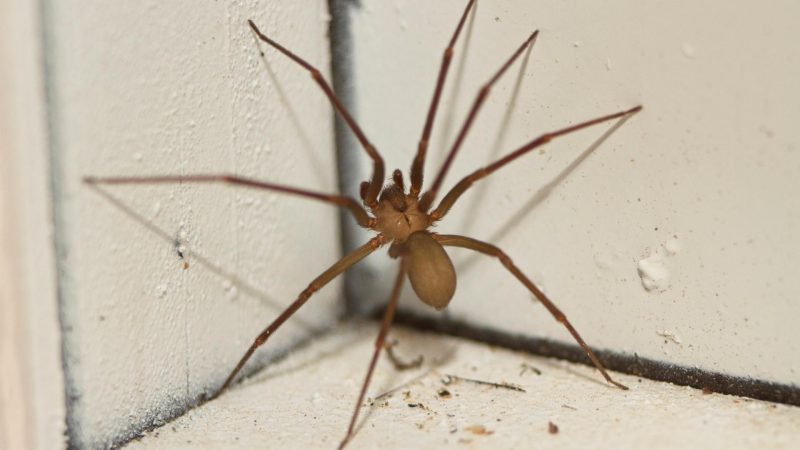
Brown recluse spiders are not commonly found in houses. Instead, they prefer outdoors under rocks, logs, woodpiles, under loose barks of dead trees and debris. However, they also enter houses and hide in dark, neglected areas such as trash cans, storage boxes, cabinets, and above-suspended ceilings.
What Attracts Brown Recluse Spiders?
Brown recluse spiders are very attracted to places where there is an abundant source of prey insects. This includes mosquitoes and roaches. crickets, firebrats, springtails, and other small and soft-bodied insects. They are not attracted to moisture, but they crawl to damp areas since there are also lots of insects there.
A light in the dark also attracts brown recluse spiders because insects are attracted to them. Interestingly, these eight-legged creatures also eat dead insects. Additionally, they are attracted to cardboard since they resemble the color of tree bark. No wonder these insect predators also hide in carton boxes.
What Are the Signs You Have a Brown Recluse Spider Infestation?
Like other insects that enter a residence, brown recluse spiders search for the same factors. They want a place to live and food to eat. These are a few indicators to watch out for:
- a confirmed sighting
- corners with webs
- where an egg sac is present
- unexplained blisters on your body that are accompanied by muscle pain
Your home is inevitably more likely to experience ongoing spider problems if you reside in a wooded location. Spiders prefer to conceal themselves in uninhabited, calm regions that are well-hidden, such as basements, and garages, attics, closets.
How to Get Rid of Brown Recluse Spiders Outside?
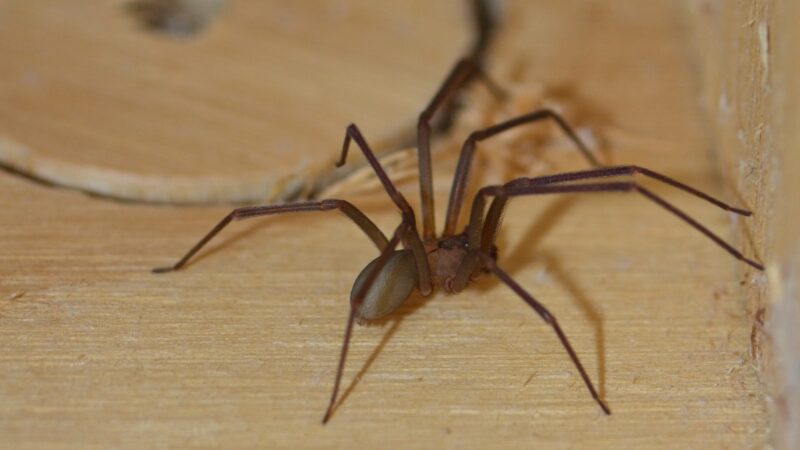
Brown recluse spiders populate easily outdoors, and getting rid of them can be very challenging. This is very true, especially if the area is the right environment for them. Therefore, the key here is to remove their food sources and their potential hiding areas. Here are some tips on how to get rid of brown recluse spiders outside:
- Cut tall grass around your house, and remove debris in your backyard.
- Remove rocks, old boards, woodpiles, and other spider-sheltering objects.
- Declutter your garage and throw away unnecessary items.
- Close your toolbox tightly in your garage. Do the same for other storage containers.
- Place firewood in sealed areas only, and move them far from your house.
- Always cover your garbage cans, and clean them thoroughly after emptying.
- Reduce outside lighting and use sodium vapor lights only. This will help get rid of insects, which are the favorite diet of spiders.
Related: How to Get Rid of Spiders in Your Car | Simple Solutions and Prevention Tips
How to Kill Brown Recluse Spiders in Your House?
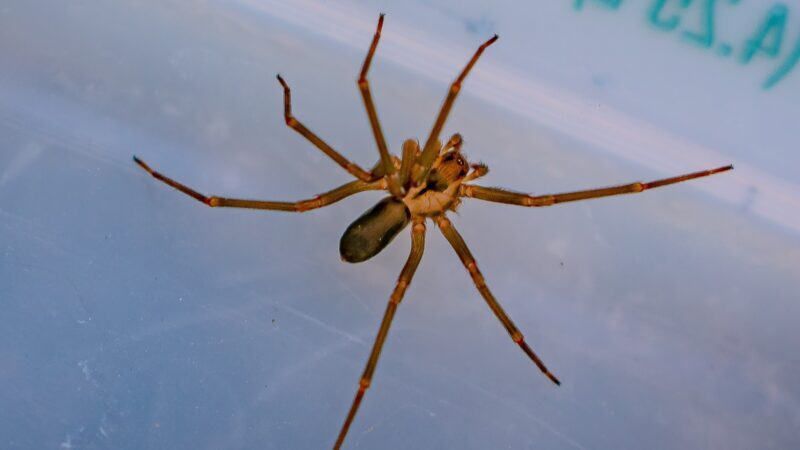
It’s not recommended to kill brown recluse spiders inside your house because of their benefits. But once they become uncontrollable, you have no other option but to kill them. However, avoid smashing them because the babies inside them might disperse. Here are some other effective ways to kill them at home:
1. Vacuum the spiders one by one. You should vacuum the walls and floors even if you don’t see any spiders. Spider eggs are very small, and lots of them could be inside your house.
2. Place some insects inside a tall bottle so they can serve as bait. Leave the bottle in areas where spiders travel. Once spiders enter the bottle, kill them.
3. Apply Food-grade Diatomaceous Earth (DE) on their possible pathways. However, this only works effectively in dry areas.
- Natural Product - Composed of 2lbs of 100% ground freshwater...
- OMRI Listed - Listed with the Organic Minerals Research...
- Powder Duster Included - Powder duster in the bag for easy and...
- Supports a Great Cause - Harris donates 10% of profits to support...
- Made in the USA – Mined in Nevada and packaged in Georgia
4. Spread sticky traps such as RESCUE! Spider Traps all over your house. These traps are very easy to use, safe for pets, and can catch other spider species.
- Traps Spiders - The RESCUE! Spider Trap catches a variety of...
- Easy to Use – Unlike many glue traps, these spider traps are...
- Double-Sided – These traps feature a long-lasting two sided...
- Discreet – A decorative plastic shell allows these traps to...
- Made in the USA – At RESCUE!, our goal is to design and...
5. Use Terro T3206 Spider & Insect Trap or any brand of pheromone spider trap. Pheromones attract animals of the same species, which is why such traps are effective.
- Traps and kills spiders, ants, cockroaches, crickets, and other...
- Kills the “Big 3” – brown recluse, black widow, and hobo...
- Easy-to-use traps can be used flat or folded
- Use folded to hide insects from view or use flat for a larger...
- Use around the home against baseboards, in corners, behind doors,...
What Sprays Get Rid of Spiders?
1. Essential Oil Solutions
Mix some essential oils with water and spray the mixture directly on the spiders. Among the essential oils that repel spiders are peppermint, eucalyptus, neem, citrus, and citronella. However, you may need to spray from time to time.
2. Boric Acid
Mix 1 tablespoon of boric acid with 1 cup of warm water to make a boric acid spray. This solution kills spiders by spraying it directly on their bodies. However, boric acid is dangerous to pets and humans once ingested. It can also kill plants.
- BORIC ACID: Boric acid, also known as boracic acid or orthoboric...
- MULTIPURPOSE CLEANING: Versatile in nature, this fine powder is a...
- INDUSTRIAL GRADE: With its industrial-grade strength, our Boric...
- LAUNDRY USAGE: Elevate your laundry game by incorporating this...
- DEODORIZING POWER: Experience the deodorizing capabilities of our...
3. Vinegar and Water
Mix equal parts of white vinegar and water in a spray bottle. Spiders cannot stand the smell and taste of the mixture so they will crawl away. The acetic acid in the vinegar is also harmful to them but harmless to humans.
Related: Outdoor Spider Control: 7 Best Outdoor Spider Sprays Review
Natural Ways to Get Rid of Brown Recluse Spiders
Turn off Lights
Leaving lights on at night attracts flying insects. This draws spiders on that spot and gathers for a meal. You may lessen the amount of prime spots where spiders could congregate by turning off your lights when not in use, especially lights outside your house.
Reduce Clutter and Vegetation
Many spiders, including the brown recluse, prefer to stay hidden in seldom-touched areas outside. If your home has this spot, this gives spiders and other pests a sheltered place to hide out undetected, right up against the side of your home. So, better try to clear out cluttered spaces.
Seal spiders
Closing exterior access sites, such as tiny spaces around windows, doors, vents, pipes, and drains, will help keep spiders out of your home. Make sure crevices are adequately sealed or screened, depending on the situation, to keep spiders out.
Spider Sweep
For the purpose of removing spiders, egg sacs, and webs from the house, a specific brush known as a cobweb brush is used that is hooked to a long pole. This method is particularly efficient in reducing spider populations over the long run. It not only gets rid of adult spiders and their webs, but it also disturbs and destroys egg sacs that would otherwise hatch into a lot of additional spiders.
Vacuum Them Up
There’s no reason to freak out if a spider invader shows up every so then. Simply pick up the vacuum and suction it up!
How to Prevent Brown Recluse Spider Home Infestation?
Brown recluse spiders prefer outdoors over indoors, but it does not mean they will not enter houses. Just like most spider species, they are nocturnal creatures, which means that they are most active at night and they rest during the day. So, to prevent spider infestation inside your home, try these simple strategies:
- Seal cracks around your house and repair all damaged window screens.
- Always keep your windows, doors, drawers, and cabinets closed.
- Conduct regular inspections in dark areas, such as attics and basements.
- Avoid clutter inside your house, especially in bedrooms and bathrooms.
- Don’t use cardboard as storage boxes. Instead, use plastic ones.
When to Call a Pest Control Expert?

Brown recluse spiders are very persistent creatures and can be everywhere, especially during the fall season. If you have already tried all the tips above, but spiders still continue to appear in huge numbers, it’s now time to call a pest control expert. They can also help you identify the different types of spiders.
List of Sources
Vetter, R. S. (2018). Brown Recluse and Other Recluse Spiders. University of California Agriculture & Natural Resources.
Potter, M. F. (2018). Brown Recluse Spider. University of Kentucky.
Potter, M. F. (2018). Eliminating Spiders Around Homes and Buildings. University of Kentucky.
Peairs, F. B., Cranshaw, W. S., Cushing, P. E. (2013). Spiders in the Home. Colorado State University.
- How to Get Rid of Copperheads | Practical Guide - August 27, 2023
- How to Get Rid of Corn Snakes | What Makes Them Aggressive? - August 27, 2023
- How to Get Rid of Alligators | Safety Measures and Removal Methods - July 16, 2023




